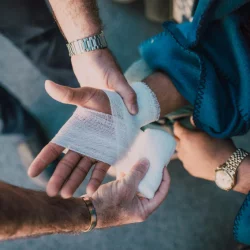How Technology is Helping to Uncover Hidden Cases of Nursing Home Abuse
Nursing home abuse remains a significant and troubling issue, often shrouded in secrecy due to its hidden nature. Many families entrust their loved ones to these facilities, expecting quality care and protection. However, the harsh reality is that abuse can occur behind closed doors, hidden from the eyes of regulators and family members. Fortunately, technology is making strides in uncovering these hidden cases of abuse, offering new hope and tools for ensuring the safety of our elderly population.
Understanding Nursing Home Abuse
Based on www.toplegaladvocate.com, nursing home abuse manifests in various forms, including physical, emotional, and financial abuse. Physical abuse involves causing bodily harm through force or neglect, while emotional abuse may include verbal harassment or psychological manipulation. Financial abuse often sees residents being exploited or having their resources misappropriated. Despite the different types of abuse, a common challenge is the lack of visible evidence, making it difficult to detect and address these issues.
Detecting abuse is fraught with challenges due to the vulnerable nature of nursing home residents. Many victims may be unable or afraid to report mistreatment, leaving family members and authorities in the dark. This concealment can perpetuate the cycle of abuse, as perpetrators may exploit the lack of oversight. As a result, uncovering these hidden cases requires innovative solutions that go beyond traditional monitoring methods.
Technological Advancements in Surveillance
Modern surveillance technology has revolutionized the way we monitor nursing home facilities. Closed-circuit television (CCTV) cameras are now commonly installed in common areas and sometimes even in private rooms, providing a continuous record of activities. These cameras not only deter potential abusers but also offer crucial evidence if a complaint arises. High-definition cameras and real-time feeds ensure that caregivers’ actions are transparent and accountable.
Wearable technology also plays a significant role in safeguarding residents. Devices like smartwatches and health monitors can track vital signs and detect abnormal patterns that may indicate abuse or neglect. For example, a sudden drop in heart rate or a drastic change in sleep patterns could prompt immediate investigation. This technology enables proactive monitoring, ensuring that any potential issues are addressed swiftly.
In addition to these advancements, integrated monitoring systems are becoming more sophisticated. Some facilities now employ smart sensors that detect unusual movements or sounds, such as sudden falls or cries for help, and alert staff or emergency services in real time. These sensors, when combined with AI analytics, can provide a comprehensive overview of each resident’s well-being, ensuring that any potential signs of abuse or neglect are quickly identified and addressed. This multi-layered approach enhances the overall safety and care quality within nursing homes.
Data Analytics and Artificial Intelligence
Data analytics and artificial intelligence (AI) are transforming the approach to uncovering nursing home abuse. By analyzing large volumes of data from medical records, incident reports, and surveillance footage, patterns of abuse can be identified. AI algorithms can detect anomalies in behavior or health data that might suggest mistreatment, such as frequent injuries or inconsistencies in care routines.
For instance, AI can flag discrepancies between reported and actual medical conditions, prompting further investigation. In recent cases, AI-driven analysis has uncovered patterns of abuse that were previously missed, leading to timely interventions and improved resident safety. These technological advancements not only enhance detection but also contribute to more accurate and efficient investigations.
Technology in Reporting and Investigation
Technological innovations have also streamlined the reporting and investigation processes. Mobile apps and online platforms now allow for confidential and immediate reporting of suspected abuse. These tools empower residents, their families, and even staff to report concerns without fear of retaliation. The ease of reporting ensures that potential abuse is brought to light faster, facilitating quicker responses from authorities.
Additionally, technology aids in the collaboration between investigators, legal professionals, and family members. Shared digital platforms enable real-time communication and access to evidence, making the investigative process more transparent and efficient. Digital documentation tools ensure that evidence is preserved accurately, which is crucial for legal proceedings and obtaining justice for victims.
Ethical and Privacy Considerations
While technology offers significant benefits in uncovering nursing home abuse, it also raises important ethical and privacy concerns. Increased surveillance can lead to potential invasions of privacy for residents, who may feel their personal space is being monitored excessively. Balancing safety with respect for individual dignity is a crucial consideration in implementing these technologies.
Regulations and guidelines are essential to ensure that technology is used responsibly. Privacy laws and ethical standards help protect residents from unnecessary intrusions while allowing for effective monitoring. It is important for nursing homes to adhere to these regulations and for technology providers to work within these frameworks to safeguard the rights and well-being of elderly individuals.
Moreover, consent is a critical component in the ethical use of surveillance technology. Residents and their families should be fully informed about the extent and purpose of monitoring, and their consent should be obtained prior to implementation. Transparent communication helps build trust and ensures that surveillance measures are not only effective but also respectful of residents' personal boundaries. Establishing clear policies and regularly reviewing their impact on privacy can help strike the right balance between safety and dignity.
Conclusion
Technology is proving to be a powerful ally in the fight against nursing home abuse. From advanced surveillance systems and wearable devices to data analytics and AI, these tools are enhancing our ability to detect and prevent abuse, ensuring a higher standard of care for vulnerable residents. As technology continues to evolve, it is crucial to address ethical concerns and maintain a balance between safety and privacy. By leveraging these innovations responsibly, we can better protect our elderly population and uncover hidden cases of abuse, fostering a safer and more transparent environment in nursing homes.
More to Read:
Previous Posts:




